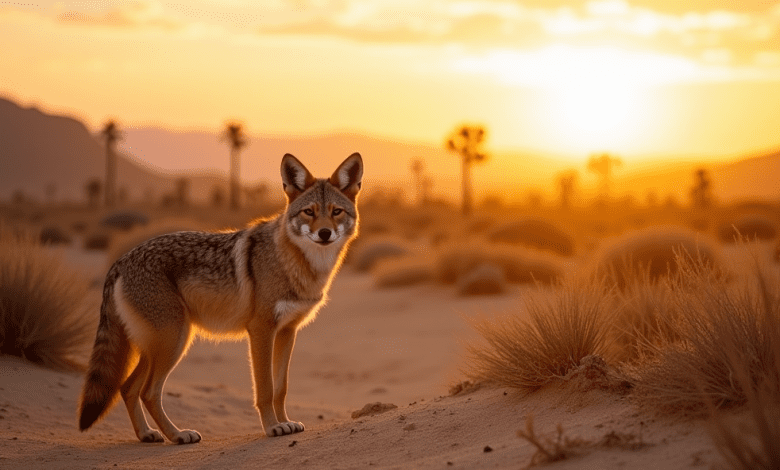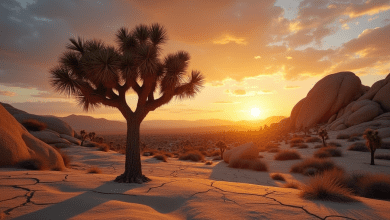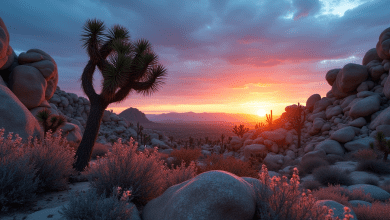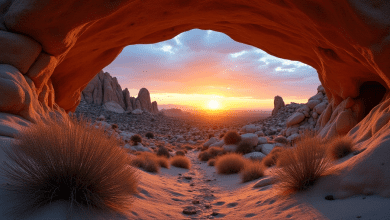Discover the Fascinating Coyotes of Joshua Tree National Park: A Complete Guide to Their Habitat and Behavior

Coyotes in Joshua Tree National Park: A Fascinating Look at Nature’s Adaptable Predator
Introduction
Joshua Tree National Park, renowned for its striking landscapes, unique flora, and diverse wildlife, is home to one of North America’s most iconic creatures: the coyote. These adaptable predators not only play a vital role in the park’s ecosystem, but they also have become a symbol of the wild beauty of the American Southwest. In this article, we will explore the characteristics, behavior, and conservation of coyotes in Joshua Tree National Park, providing readers with a comprehensive understanding of these fascinating animals.
Understanding Coyotes: The Basics
What Are Coyotes?
Coyotes (Canis latrans) are medium-sized canines that belong to the family Canidae, which also includes wolves, foxes, and domestic dogs. They are highly adaptable animals that can thrive in a variety of habitats, including deserts, forests, and urban areas. In Joshua Tree National Park, these creatures are often spotted roaming the rugged terrain, showcasing their incredible survival skills.
Physical Characteristics of Coyotes
Coyotes are distinguished by their slim, elongated bodies, pointed ears, and bushy tails. They typically weigh between 24 to 46 pounds and stand around 21 to 24 inches tall at the shoulder. Their fur is generally a mix of gray, brown, and tan, providing excellent camouflage in their desert environment. This coloration helps them remain undetected by both prey and potential predators.
The Role of Coyotes in the Ecosystem
Top Predators of the Desert
As apex predators, coyotes play a crucial role in maintaining the balance of the ecosystem within Joshua Tree National Park. They primarily prey on small mammals such as rabbits, rodents, and birds. By controlling these populations, coyotes help prevent overgrazing and promote healthy vegetation growth, which in turn supports the entire food web.
Scavengers and Their Importance
Beyond being hunters, coyotes are also opportunistic scavengers. They will feed on carrion, fruits, and insects when the opportunity arises. This adaptability is essential for their survival, especially in challenging desert environments where food sources can be scarce. By feeding on dead animals, coyotes help sanitize the environment and contribute to nutrient recycling.
Coyote Behavior: Insights into Their Life
Social Structure and Communication
Coyotes are known for their complex social structures, often living in family groups. These groups typically consist of a mated pair and their offspring from the previous year. Communication among coyotes is crucial for maintaining social bonds and coordinating hunting efforts. They utilize a range of vocalizations, including howls, yips, and barks, to convey information to one another and establish territory.
Breeding and Raising Pups
The breeding season for coyotes usually occurs from late winter to early spring. After a gestation period of about 63 days, a female typically gives birth to a litter of four to seven pups. During the first few weeks of life, the pups are entirely dependent on their mother for food and protection. As they grow, both parents play a role in teaching their young essential survival skills before they disperse to find their own territories.
How to Safely Observe Coyotes in Joshua Tree National Park
Best Practices for Wildlife Viewing
For visitors hoping to catch a glimpse of these elusive creatures, observing coyotes in their natural habitat can be an unforgettable experience. Here are some tips for safely seeing and appreciating coyotes while ensuring their well-being:
- Keep Your Distance: Always maintain a safe distance from coyotes. Use binoculars or a camera with a zoom lens to observe them without disturbing their natural behavior.
- Never Feed Wildlife: Feeding coyotes can lead to dangerous habituation, where they lose their natural fear of humans. Always keep food secured and never approach or feed wild animals.
- Respect Their Territory: Coyotes are territorial animals. If you spot one, observe quietly and allow it to move away without interference.
- Visit During Early Morning or Dusk: Coyotes are crepuscular, meaning they are most active during dawn and dusk. Visiting during these times increases your chances of catching sight of these fascinating predators.
Conclusion: The Significance of Coyotes in Joshua Tree National Park
Coyotes are integral to the ecosystem of Joshua Tree National Park, serving as both predators and scavengers. By understanding their behavior, role in the environment, and how to observe them responsibly, we can better appreciate these remarkable animals. As you explore Joshua Tree’s beautiful landscapes, keep an eye out for a coyote — you might just get a glimpse of one of nature’s most adaptable and innovative predators. Respecting their space and habitat is crucial for ensuring that future generations can continue to marvel at these iconic canines in the wild.




